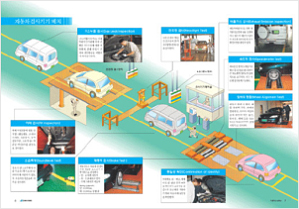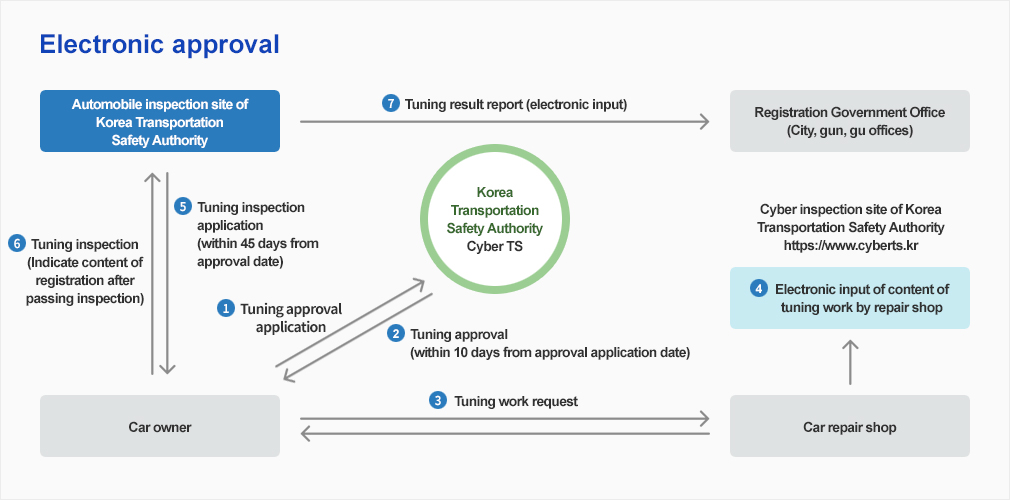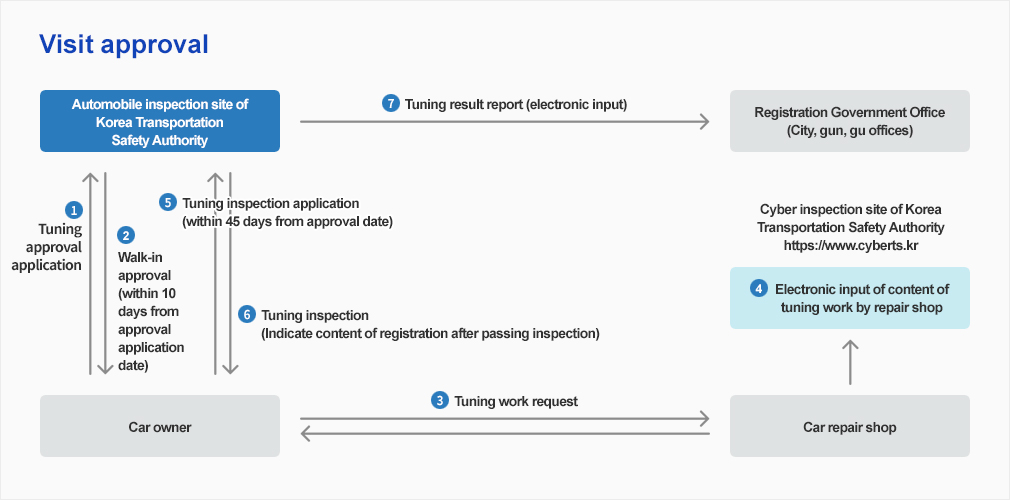Residence
Regular Inspection
HOME > Residence > Vehicles > Regular Inspection
Objectives
- To ensure the safety of a vehicle and protecting the lives and property of the Citizens from traffic accidents by checking whether a vehicle is roadworthy.
- To prevent damage and to establish driving rules by identifying uninsured and illegally modified vehicles
- To prevention criminals and authenticate ownership by checking the vehicle's identity
- To prevent environmental pollution caused by emissions and noise
Vehicle Inspection Types
New Inspection
- The inspection required for the initial registration of a vehicle
Periodic Inspection
- The regular inspection that is required after initial registration
Structural Modification Inspection
- The inspection required when modifying the structure or equipment in a vehicle
Temporary Inspection
- Irregular inspection implemented under the Vehicle Maintenance Act or as ordered by the Vehicle Maintenance Act or upon request by the owner of the vehicle
- Repair Inspection : Inspections conducted before operating a repaired car after full-loss processing
Regular Inspection
Inspection Standards
- A vehicle is inspected
- - Check whether the structure and devices of a motor vehicle comply with the "Motor Vehicle Management Act" and the automoive safety standard
- - Check whether exhaust gases (CO, HC, λ, smoke) are acceptable in accordance with the allowable exhaust standard specified by the "Clean Air Conservation Act"
- - Check whether horn sound and exhaust noise are acceptable in accordance with the "Noise and Vibration Control Act"
- - Check the tempering of items which require tuning approval in accordance with the "Motor Vehicle Management Act"
Inspection Items
- Compliance with the "Motor Vehicle Management Act" enforcement regulation [Attachment 15].
Comprehensive inspection: regular inspection + exhaust gas precision inspection (or light motor vehicle exhaust gas inspection)
Inspection Standards and items
- "Motor Vehicle Management Act" enforcement regulation [Attachment 15], "Clean Air Conservation Act" [Attachment 26], or the "Special Act on Metropolitan Air Quality Improvement".
In accordance with the enforcement regulation [Attachment7]
Implement of Vehicle Inspection
Term of Validity
| Category | Inspection effective period | |
|---|---|---|
| Non-commercial passenger car & towed car | 2 years (First inspection effective period is 4 years in the case of cars which have received new inspection in accordance with Statute Article No. 43 Item 5) | |
| Commercial passenger car | 1 year (First inspection effective period is 2 years in the case of cars which have received new inspection in accordance with Statute Article No. 43 Item 5) | |
| Light, small passenger cars & trucks | 1 year | |
| Commercial large trucks | Cars less than 2 years old | 1 year |
| Cars older than 2 years | 6 months | |
| Mid-size passenger cars & commercial large-size passenger cars | Cars less than 8 years old | 1 year |
| Cars older than 8 years | 6 months | |
| Other cars | Cars less than 5 years old | 1 year |
| Cars older than 5 years | 6 months | |
Note) Apply the inspection validity period of passenger cars in the case of passenger cars made to transport less than 10 people (excluding cars applicable from (Ga) to (Da) of Article 2 Item 1 No. 2) and registered prior to December 31, 2000.
Service Charge
(Unit: KRW, VAT included)
| Category | Motor vehicle inspection fees | ||||
|---|---|---|---|---|---|
| Light | Small | Medium | Large | ||
| Regular inspection | 17,000 | 23,000 | 26,500 | 29,000 | |
| Comprehensive inspection | Load | 48,000 | 54,000 | 56,000 | 65,000 |
| No load | 34,000 | 39,000 | 45,000 | 49,000 | |
| Emission exemption | 15,000 | 20,000 | 24,000 | 26,000 | |
| Tuning inspection | 31,000 | 36,000 | 40,000 | ||
| Temporary inspection | General | 16,000 | 21,500 | 25,000 | 27,000 |
| Car age extension | Regular inspection & comprehensive inspection fees applied | ||||
| New inspection | Domestic revival | 30,000 | 33,000 | 35,000 | |
| Certification exemption | 131,000 (Including self certification waive checking fees 11,000 won) | ||||
| Repair inspection | 110,000 | 130,000 | 140,000 | ||
* Small car fees applied to passenger cars (including passenger cars for 10 people or fewer)
Penalty
| Violations | Fines |
|---|---|
| If a regular inspection is not received in accordance with Article 43 Item 2.1 of the "Motor Vehicle Management Act" or a comprehensive inspection in accordance with Article 43 Item 2.1 of the "Motor Vehicle Management Act" | |
| If inspection delay period is less than 30 days | 40,000 KRW |
| If inspection delay period is over 30 days and less than 114 days | Add 20,000 KRW for every 3 days after the 31st day |
| If inspection delay period is over 115 days | 600,000 KRW |
※ Be sure to make a reservation before your visit, as the inspection place of the Korea Transportation Safety Authority operates via a reservation system. If you do not make a reservation, you may not be able to receive an inspection on the day that you visit. (Check the "Cyber Inspection" portal site (www.cyberts.kr))
- Inspection Process and Description

Approval for Structural Modifications
A system to prevent traffic accidents and environmental contamination through inspection of the safety of cars after a structural change.


Approval subjects
| Category | Approval subjects |
|---|---|
| Structure | Length, width, height |
| Total weight (sum of car weight, maximum load, and weight obtained after multiplying riding capacity by 65 kg) | |
| Device | Steering apparatus |
| Brake | |
| Fuel system & electric/electronic devices (Limited to fuel devices and High-Power Electric Devices in accordance with Article 2 Item 52 of the "Safety and Performance Regulations for Motor Vehicles and Parts") | |
| Car frame & car body | |
| Connecting devices & towing devices | |
| Passenger boarding devices & goods loading devices | |
| Noise prevention device | |
| Exhaust gas emission prevention device | |
| Other lighting devices such as headlight, license plate light, taillight, stop lamp, sidelight, backlight, etc. | |
| Pressure-resistant container & auxiliary devices | |
| Other devices needed for safe driving of cars specified by the Ordinance of the Ministry of Land, Infrastructure and Transport |
Service charge
| Category | Walk-in approval | Electronic approval |
|---|---|---|
| Structure & device change | 60,000 KRW | 35,000 KRW |
| Device change | 35,000 KRW | 21,000 KRW |
Types of illegal structural modifications

Wide tires and negative wheels
- Lowered fuel efficiency because of the increased driving resistance
- Higher possibility of the vehicle rolling over because of the raised height
- A pedestrian might be caught by the wide tires
- Wheel bolts may break as the mechanical load on wheel nuts increases
- Longer braking distance as the vehicle becomes heavier

Modification of metal bumper guard and body bottom
- Damages the counterpart vehicle or pedestrians more seriously in a car accident
- Higher possibility of rollover because of the raised height
- Longer braking distance as the vehicle becomes heavier
- Shortened vehicle life because of the increased mechanical load on the body bottom

Sharp metal spoiler
- Possible to damage pedestrians with the projected sharp metal spoiler FRP spoilers installed within the allowable range are allowed.

Subsidiary frames on the cargo compartment (Illegal modification)
- Longer braking distance and road damage due to overloading
- Shortened vehicle life and excessive emissions
- Violate safety standards: Since the rear safety plate is removed, it is more likely that the passengers in a real collision vehicle are damaged more seriously

High-brightness LED lamps
- High-brightness LED lamp using sapphire lights installed in the rear could interrupt the view of the driver to the rear

Colored (coated) rear lights or illegal lights
- Lowered visibility and misunderstood signal could cause a traffic accident
- Stop lights : Red
- Number lights : White
- Winker : Yellow

Colored (coated) rear lights or illegal lights
- Shortened visible distance and unable identification of obstacles resulted from the blockage of head light's brightness may prompt a serious accident.
- Confused visibility due to changed winker colors

Clear Lamps
- Confused visibility due to diffusion of light colors when lights are on simultaneously
- Shortened available area of lighting
※ Except the vehicles that receive part certificates from the safety test agency

Search Lights
- Illegal lights that are undefined in safety standards and used for other purposes or interrupt vision

Neon Light Frame
- Installed around the number plate decorating with neon lights. It may be misused for running away The number plate with neon lights is hard to identify when the vehicle violates traffic regulations

Modification of Air Cleaner Inhaler Opening (Illegal revision)
- If the air cleaner inhaler opening is installed on the bumper bottom, water or other foreign particles could inflow to the engine to deteriorate its performance
- Since water is non-compression liquid, it damages cylinders and pistols.
- The projected tires may be dangerous to pedestrians or worsen fuel efficiency

Engine Hood Up
- If the motor hood (bonnet) is installed while it is raised up, it may directly harm the driver
when a collision takes place because the engine hood is not bent.
※ Indication : Conduct temporary inspection after ordering recovery to the original shape or to receive after have it repaired

